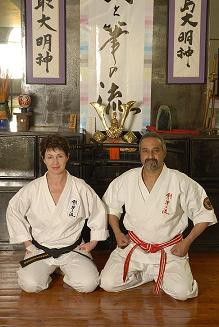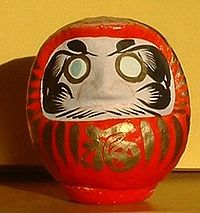|
|
|
A dojo (道場) is a
Japanese term which literally means "place of the Tao". Initially, dojo were
adjunct to temples. The term can refer to a formal training place for any of
the Japanese do arts but typically it is considered the formal gathering
place for students of any Japanese martial arts style to conduct training,
examinations and other related encounters.
The concept of a dojo as a martial arts training place is a Western concept;in Japan, any physical training facility,including professional wrestling
schools, may be called dojos depending on the context.
|
 |
 |
 |
|
A proper Japanese
martial arts dojo is considered special and is well cared for by its users.
In many styles it is traditional to conduct a ritual cleaning of the dojo at
the end of each training session (called souji, which translates from
Japanese as "cleaning"). Besides the obvious hygienic benefits of regular
cleaning it also serves to reinforce the fact that dojo are supposed to be
supported and managed by the student body, not the school's instructional
staff.
Many traditional dojo follow a prescribed pattern with shomen ("front") and
various entrances that are used based on student and instructor rank laid
out precisely. Typically students will enter in the lower-left corner of the
dojo (in reference to the shomen) with instructors in the upper right
corner. Shomen typically contains kamidana (神棚)—an
area for a Shinto shrine in some instances typically found in Japan and
other artifacts.Some dojos like ours contains the Samurai Warriors Helmet
- Kabuto (兜, 冑) and Samurai Swords
日本刀
Many other artifacts may be displayed throughout the dojo, such as kanban
that authorize the school in a style or strategy, and items such as
tatami(mats)(畳), makiwara -(巻藁)
(striking board), punching bags, striking pads, Taiko -(太鼓) (Drum)
or armor (yoroi). It is not uncommon to find the name of the dojo and the
Dojo Kun (roughly "dojo rules") displayed prominently at shomen as well.
Visitors also typically have a special place reserved, depending on their
rank and station. Weapons and other training gear will normally be found on
the back wall.
The kabuto-Samurai Warriors Helmet of Date
Masamune, along with the German Stahlhelm, were the inspiration for the
helmet of Darth Vader. Vader’s helmet, armour and robe is highly reminiscent
of samurai armour. The helmet is taken directly from the menpō mask and
kabuto helmet of a feudal samurai. Vader also wore an under-robe of black
that resembled long, flared out pants, called hakama, a garment worn in
feudal Japan. The Kabuto was also the inspiration for the Pokémon Kabuto,
and Kabutops. |
 |
|
Daruma dolls (達磨 ), also known as dharma dolls,
are hollow and round Japanese wish dolls with no arms or legs, modeled after
Bodhidharma, the founder and first patriarch of Zen. Typical colors are red
(most common), yellow, green, and white. The doll has a face with a mustache
and beard, but its eyes only contain the color white. Using black ink, one
fills in a single circular eye while thinking of a wish. Should the wish
later come true, the second eye is filled in. It is traditional to fill in
the left eye first; the right eye is left blank until the wish is fulfilled.
Many of the Daruma dolls are male but there is a female daruma doll. It is
called hime daruma or "princess daruma."
The Daruma dolls return to the upright position
after being tilted to one side. As such, the daruma has become symbolic for
optimism, persistence, and strong determination.
- Hi ni! fu ni!
- Fundan Daruma ga
- Akai zukin kaburi sunmaita!
- Once! twice!
- Ever the red-hooded Daruma
- Heedlessly sits up again!
|
|
|
|
|